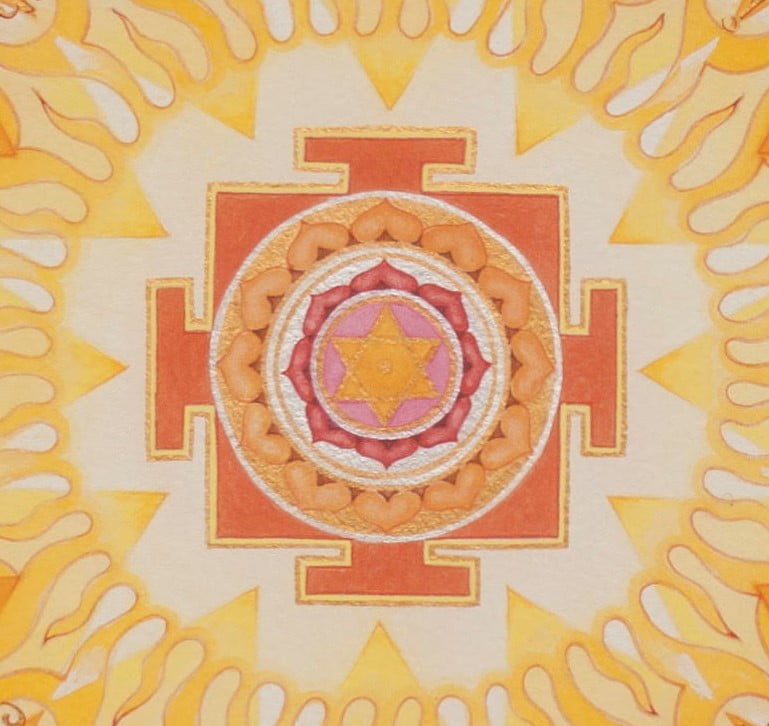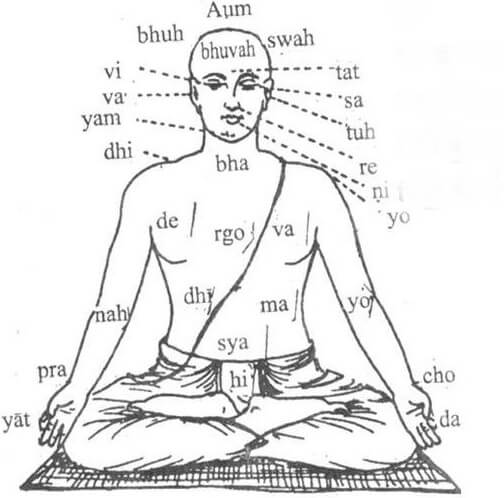
- Mantra Meditation
- What is a Mantra?
- Meaning of Mantra
- The effect of Mantra on body and mind
- Vibration in the subconscious
- Mantra Meditation as concentration training
- Personal relationship with a Mantra
- Tools for Mantra Meditation
- Instructions for Mantra Meditation
Meditation and Mantra Meditation
Mantra meditation differs from other forms of meditation in the use of a mantra as a direct object of meditation. As a meditation object, a mantra has a high energetic potential due to its three levels. Content, vibration and effect. In other forms of meditation, such as walking meditation or breathing meditation, the meditation object is calming or passive. In meditation, we strive to focus on an object with long-lasting concentration and a relaxed posture at the same time. This creates a flow between the meditator and the object of meditation, in which the vibration of the mantra penetrates into the deeper layers and can dissolve deep-seated blockages. When actively meditating on a mantra, our mind is conversely put into an alert and clear state.
What is a Mantra?
Many well-known mantras first appeared in the Vedas, written down by yogis who heard and wrote down these mantras in deep meditation. Through the sound and meaning of these words in a certain order, a mantra generates energy, which creates a vibrational field by stringing the words together.
A mantra consists of sound syllables that are able to influence the body and psyche through vibrations – especially the subconscious. It has been scientifically proven that the universe and everything in it consists of vibrations. The positive vibration of a mantra can therefore heal us down to the deepest cell. A mantra exists on three levels. In terms of content as a vibration and an individual effect on the mind. Mantras exist in all cultures and are used for healing prayers, meditation or stories.
Auṃ maṇi padme hūṃ ( AUM MANE PAD ME HUM )
Buddhist Mantra¹
Meaning of Mantra
Here you will find a more detailed explanation of the meaning of a mantra using a specific example. The word mantra comes from Sanskrit (mantrana), which means suggestion or suggestion. In principle, every human word is a mantra. We use words as tools in everyday life to give meaning to things and exchange information. Every word or mantra is also an acoustic tone to which the mind responds. There are countless mantras from different cultures, most of which are used for healing or for a positive effect. Every mantra, like every word, therefore has an individual function and history.

The effect of Mantra on body and mind
Mantra meditation particularly involves the left hemisphere of the brain and causes the networking of new neural pathways in the brain and positive emotions. Songs, poems or hymns can activate new areas in our brain through frequencies. As an object of meditation, it is so potent because the mind is purified by the pure qualities of a mantra. In contrast to a passive meditation object, a mantra also has a positive influence on our mind. There is not only a positive effect for the person who recites a mantra aloud or internally, but also for the listener.
Vibration right into the subconscious
95% of our behavior and perception is controlled by the subconscious. The deep-seated imprints of negative experiences can cause mental and physical illnesses. The vibration of the mantra reaches the subconscious and can release these blockages. New neural pathways connect in the brain and a positive change takes place on all levels..

Mantra Meditation as concentration training
By constantly repeating the mantra over a long period of time, we strengthen our ability to concentrate enormously. This is not to be confused with effort or sheer willpower, which leaves us exhausted over time. We can focus on things that we simply like for a particularly long time and without losing energy. This is a very individual matter and therefore completely different for each person. If you then find a mantra that suits you, you can achieve amazing abilities in terms of stamina and concentration. Strong concentration is the basis for deep meditation.
Personal connection to a mantra
Depending on the meditator’s disposition, a connection to a mantra can arise. It can be sung lovingly or simply repeated inwardly as an object of meditation. This creates an interaction with the energy of the mantra. A loving connection is helpful, but not a prerequisite for a successful meditation practice.
Tools for Mantra Meditation
A seat cushion is required to ensure a comfortable posture. A blanket may be useful if the body cools down too much. Beginners should use a mala at the start. When reciting a mantra aloud or internally, a ball is pushed further along the chain with the thumb. One round lasts 108 times. Several rounds can be recited or less than one round. Depending on how much time is available. The length of a mala can vary greatly depending on the length of the mantra and the speed of recitation.

Mantra meditation offers an ideal introduction to meditation and is itself suitable as a lifelong practice. Mantras often seem strange to us, but have the potential to bring about intense spiritual experiences and changes in behavior. Concentrating on the mantra with a mala makes it easier to focus the mind on the object of meditation. With a mala, we can concentrate better on the mantra because we have an additional focus through the hand movement and give the mind another point of focus by counting through hand movement. The mala helps us not to wander off during mantra meditation. At the same time, there is a clear path and a goal to which we can return in meditation if the mind wanders off. When in doubt, we always come back to the mantra.
Instructions for mantra meditation for beginners
- Sit comfortably in the meditation position and close your eyes. If you have a mala, take it in your hand as described in the picture and repeat the mantra for a set length that you have set for yourself.
- Hold the mala with your middle finger and move it with your thumb with each recitation of the mantra. Do not touch it with your index finger.
- Right from the start, try to recite the mantra internally with good concentration and inner relaxation. Don’t strain yourself too much, but be focused.
- The recitation of the mantra will be interrupted by thoughts. Become aware of this interruption and gently return to the mantra without haste or effort..
- At the end of the meditation, remain seated for 10 minutes and allow the energetic effect to take effect. Allow everything that is going on inside you, allow every inner movement to come and go.
Quotes
1 https://en.wikipedia.org/wiki/Om_mani_padme_hum